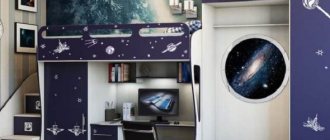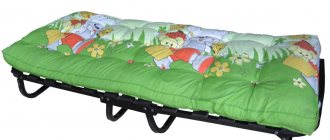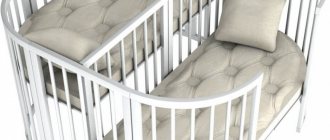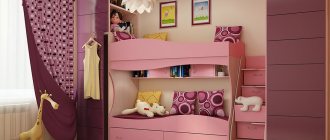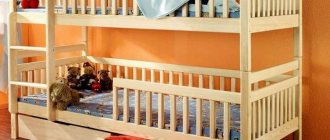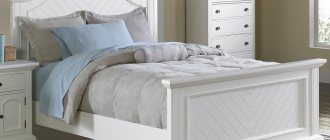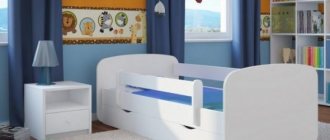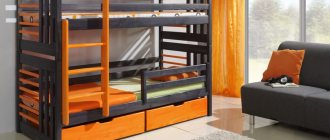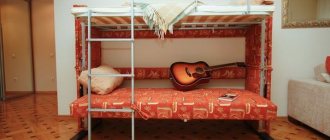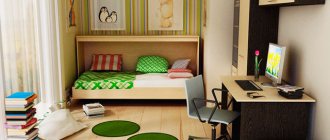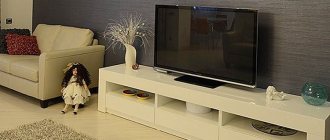In small rooms there is always a lack of free space, especially if two people live in such rooms at the same time. To solve the problem of saving space, built-in beds are especially popular, but they are ineffective for two kids in a children's room. A corner bunk bed makes it possible to free up space for rest and play, and also provides children with separate sleeping areas. The design of the bed provides for the arrangement of sleeping places perpendicular to each other. Thus, the sleeping areas are located at some distance and form individual spaces for resting children or adults.
What is
A corner bed is a model equipped with sides along the headboard and one of the sides. This design allows you to use the space of the room to the maximum. Its main advantage is filling space in the corners. The models are so diverse that they fit any style direction.
Modern children's corner beds often do not look like an ordinary piece of furniture. They are often connected to a workplace, cabinets and storage shelves, and sports equipment (rope, rings, wall bars). The main problem with such models is that you need to choose a place for them in advance. Since the designs are left- and right-handed with sides on the corresponding side, the back side of the furniture does not have a very attractive appearance.
If an ordinary bed can be placed in any corner or in the center of the room, then a corner bed should immediately occupy a certain place.
There are two-tier options that can accommodate a couple of children; some models can accommodate three or more children. Such designs save space in the room and parents’ finances. For children, bunk models are more interesting than regular beds. They are made in a variety of ways:
- traditionally (one bed is located above the other);
- bed with desk in the lower tier;
- two or more sleeping places located perpendicular to each other at different levels;
- one of the places rolls under a stationary bed like a drawer in a chest of drawers.
It is recommended to install the children's bed in the corner farthest from the window, where the least amount of light enters.
Corner models are indispensable for small children's rooms. They save space, since built-in cabinets and shelves replace various bedside tables, shelves and tables, and allow you to leave the center of the room free. The side backs make the sleeping area cozy and create a personal nook for the child.
Additional equipment
When placing a bunk corner bed in the corner of a small room, due to the arrangement of sleeping places along adjacent walls, space in the center of the room is significantly saved. Thanks to this quality, the furniture has a modern look, can comfortably accommodate two people in one room and at the same time is a multifunctional item, in the sections of which you can store clothes, toys and other children's things.
By using such an arrangement of recreation areas, when the sleeping bases are not in the same plane, it is possible to install additional structures under the upper base. They are also sections and departments for convenient placement of other things. The modules are:
- Sleeping places above and below;
- Drawers for storing bed linen;
- Bedside work area in the form of a table;
- Wardrobe;
- Shelves under the top base;
- The design of the staircase to the second tier with secret sections;
- Sports equipment.
The upper floor must include a side, which serves as a fence to prevent a child from accidentally falling from a height. The module can be additionally equipped with soft headboards in the sleeping areas of both tiers.
Varieties of configuration
Designers design corner furniture for children in the form of houses, cars, toys, and spaceships. The bed is no longer just a place to sleep. Here a child can play, play sports, read, store toys, or simply make a cozy “house” of pillows.
Color combinations allow you to visually separate storage spaces, a sports corner, a sleeping area, and a work table. Double products for girls and boys are painted in different colors and decorated accordingly. These can be bunk structures or beds on the same level, connected at an angle.
Traditional with drawer
The classic corner bed is complemented by one or more drawers. As a rule, these are retractable elements located under the berth. Such designs successfully replace a chest of drawers; they store bed linen, towels, pillows, pajamas and other things.
Depending on the configuration, boxes come in two types:
- on guides (slide along slats mounted on the sides of the structure);
- on wheels.
There are models with one large drawer. If it is equipped with a wheel, then, if necessary, it can serve as an additional sleeping place. Options with two or three separate drawers are more convenient to use. They make it easier to maintain order and find the things you need. The approach to the beds can be from the side or from the end. Both options have their advantages; the choice depends on the arrangement of furniture and the preferences of the child or parents.
The traditional corner bed is suitable for children aged 3-4 years.
Attic
This is a multifunctional design, similar to a regular bed with very high legs, under which there is a workplace. The attic must have a reliable ladder and strong sides. As a rule, it is designed for one child, but there are options in which the upper tier is equipped with two beds at once.
The main advantage is versatility. The bed simultaneously serves as a place to store things, toys, books and a work or gaming table. There is only one minus - it is advisable to use the model in a room with a high ceiling. In a room that is too low, it will be inconvenient for a child to climb onto the second tier and uncomfortable to sleep: it is usually very stuffy under the ceiling.
Suitable for children aged 3–5 years, if they are not afraid to climb to the upper tier on their own. Can be used up to 15–18 years.
Non-standard shape
From a practical point of view, a non-standard bed may be needed if conventional models for some reason do not fit into the corner allocated for them. But parents care about practicality, and children care more about the appearance of the furniture. Most often, such products are chosen for arranging a nursery, trying to make it as comfortable as possible and decorate it with fun elements. Here are just a few unusual designs that are suitable for children over 2 years old:
- Corner bed "house". An imitation of a real roof is installed above the sleeping place, the wall is decorated with windows, and small light bulbs are hung. There are options designed for two children: with a playpen for the youngest and with a sofa nearby for the older one.
- A bunk bed designed like a real steam locomotive: with a chimney and a driver's booth. The lower level is decorated with imitation wheels, the second berth is located “on the roof”.
- A bed for a little princess with pink elements, luxurious pillows, a canopy, special drawers and shelves for “jewelry.”
- An irregularly shaped headboard design with soft lines and curves, designed in a cartoon style, decorated with drawings from your favorite fairy tales.
- A loft bed for a boy with an imitation of a knight's castle in the lower part. The upper tier is decorated with shields and banners. In addition to the stairs from the “castle” there is an “emergency exit” - a real slide along which you can slide down from the top floor.
Tips for choosing a children's bed made of solid wood from professionals
Models of non-standard shape are made to order, so they will cost more. But an individual approach will allow rational use of space and make the interior completely unique.
Ottoman
An ottoman can serve a child both for sleeping and just for relaxing. In the second case, compact corner models are suitable, since there should still be room in the room for a regular bed. If you sleep on an ottoman at night and play during the day, you need products that look like a sofa with a standard-sized sleeping place. Typically, this model does not have soft armrests; they are replaced by reliable sides, and decorative pillows act as a comfortable backrest. Taking into account the presence of such protective elements, the ottoman is suitable for young children (3–4 years).
Some models can be folded out to increase the width of the bed. In other modifications, a roll-out box of the same size as the main bed is installed in the lower part. If necessary, it can be used as an extra bed.
Transformer
This unusual design can “grow” with the child. A transforming bed combines several elements of furniture. It is suitable for both newborns and older children (up to approximately 12 years old). Types of transformers depending on their configuration:
- Sofa + bed. When the child grows up, the front wall is removed. The bed becomes a small sofa.
- Bed + bed. A small place for a newborn is enlarged by rearranging the structural elements and becomes a bed for a child up to 10–12 years old.
- Bed + chest of drawers. The sleeping area is complemented by a cabinet or drawers.
- Collapsible multifunctional design.
Depending on the modification, the collapsible design kit includes:
- baby changing table;
- shelves for storing diapers, baby vests, and baby care products;
- protective sides of various heights;
- pendulum mechanism for rocking a child;
- built-in side bedside table or chest of drawers, which can be turned into an independent piece of furniture as needed;
- Additional storage space under the bed bottom.
When the baby grows up, the side storage spaces are detached and placed next to the crib. The length of the bed increases noticeably, but the width remains constant (0.6 m). As a rule, a child can use a crib until his height increases to 165 cm or until the furniture becomes too narrow.
For a small room, a transformer is not the best option. Here, separate bedside tables, cabinets, and cribs placed in different corners are more suitable. Another drawback is that a standard mattress is designed to fit the original length of the bed. If you increase the size of the bed, you will need a new product.
Sofa + bed
Bed + bed
Collapsible multifunctional design
Bed + chest of drawers
Bunk
A bunk bed can accommodate two children at once, which significantly saves space. Often folding or folding tables and drawers are built into them. In addition, bunk beds have a wide variety of designs:
- Traditional models. Designed primarily for sleeping and designed for two children. They must have a staircase to the “second floor” and protective sides for the safety of the child. They have a minimum of additional functions; it can only be a shelf or a storage cabinet.
- Bunk corner beds with sports complex. A rope, a Swedish wall, and gymnastic rings are built into the free space.
- Multi-tiered options. They have three or more sleeping places, one of which can be located almost at floor level, the second - perpendicular at medium height, the third - parallel to the first, but at the very top. There are options in which the seating areas are connected by an angle at the same height, and another tier is installed above them.
- Bunk beds with work space. Models can only be designed for one child. They are arranged in such a way that the lower part is an “office” with a desk or gaming table, built-in storage cabinets, bookshelves, and the sleeping place is located on the upper tier, where a convenient ladder leads.
- Roll-out bunk beds. In appearance they resemble a high sofa, the lower tier of which slides out on special rollers when it’s time to sleep. Design advantages: compactness, absence of stairs and racks. Minus - there are no built-in cabinets and shelves. A roll-out bed is ideal for a modest-sized children's room.
If the difference between children is 2–5 years, then, as a rule, the lower “floor” goes to the youngest child so that there is no risk of falling. For children of different sexes, a bunk bed is decorated in different colors. Although such furniture looks attractive, over time one way or another you will have to arrange a separate sleeping place for each child.
Traditional
With a sports complex
Multi-tiered
With a workplace
Roll-out
Requirements for children's furniture
In order for a child to sleep soundly, a children's corner bed must be chosen correctly. The main requirements for the product include:
- environmental safety of manufacturing materials and components;
- availability of a quality certificate;
- rounded edges, non-traumatic handles, no glass elements;
- compliance with the child’s age category and physical fitness;
- calm color of the bed, shades should not negatively affect the emotional and psychological state of the baby, gentle, light colors are recommended;
- the presence of an orthopedic mattress for a comfortable and healthy sleep;
- aesthetics and functionality, the product must fully satisfy the user's requirements.
When choosing a corner children's bed, you should pay attention to reliability, practicality, strength and safety. The existing variety of shapes and sizes of this type of furniture allows it to be placed in any room of any size. Transformation mechanisms play an important role: lightweight, easy to use.
Variations of structural elements
Since the greatest load falls on the legs and base of the furniture, more stringent requirements are imposed on them. The basic elements of a crib include the frame, lamellas (slats inserted into the bottom of the frame), sides (sideboards for the safety of children) and legs - all of them are necessarily present in models of any design. Possible additional elements:
- folding or extendable tables;
- boxes;
- shelves;
- built-in wardrobes:
- sports equipment;
- stairs;
- decorative details.
Base
The frame is made in the form of a frame made of wood or metal, to which the base is attached. It is this detail that makes the bed quite comfortable and reliable. There are several options:
- Solid base. It is made from a single sheet of plywood. This design is suitable for the youngest children. However, over time it is pressed through, and depressions may appear. Most often, this option is purchased for a classic spring mattress.
- Lattice with lamellas. The slats are needed to support the mattress; they are placed at a distance of approximately 5 cm from each other. This provides an orthopedic effect and allows air to circulate freely.
Types of beds for newborns, requirements for products
The slats in modern beds are made of slightly curved upward slats. They distribute the load evenly and do not sag. When paired with a good orthopedic mattress, these elements provide reliable support for the spine. The strength of the base depends on the number of slats.
The optimal option is when the distance between the slats is equal to the width of one slats.
Solid base
Lattice with lamellas
Headboard
The headboard, along with the sides, should limit the sleeping area, ensuring safety. As a rule, it is made higher than the footboard. But it all depends on the design idea. There are high and low headboards and footboards, solid and with gaps.
These elements also differ in rigidity. For the little ones, choose a soft back or attach special sides so that the child does not get injured. For older children, any headboard is suitable, into which various shelves and drawers for books and toys are built. If your child likes to spend time sitting on the bed, then it is better to choose a high backrest. It is important that the upholstery material is wear-resistant and hypoallergenic.
The appearance, height and configuration of the backrest depend only on the design style of the bed.
Low, solid headboard
High, soft
Hard, with gaps
With drawers and shelves
Storage systems
Storage systems in children's corner beds include:
- shelves;
- lockers;
- drawers, boxes or niches.
Shelves can be located along a long or short wall. Sometimes the end wall is made in the form of an open shelving. This is a convenient place to store toys, books, and necessary little things. Open shelves are suitable for children of middle and high school age. This design is unsafe for children - a child can knock over the things displayed there. The same applies to open built-in niches.
A closed wardrobe built into the bed frame is convenient because it allows you to keep your sleeping area clean. It is safe for children of any age.
There are two types of boxes:
- on guides;
- on rollerskates.
If you plan to use them only for storing things, then you can choose models with guide bars. However, it will be easier for your child to pull them out if they are equipped with wheels. In the case where the bottom drawer serves as a sleeping place, it must be equipped with casters to provide reliable support during sleep.
There are also options when there are spacious niches under the base of the bed.
What else to pay attention to when zoning
To make being in the room as comfortable as possible, you need to think through a few points in advance.
Firstly, a lighting source must be provided for each resident. This could be a table lamp on the bedside table or a sconce on the wall above the head of the bed. This question becomes relevant when it is not possible to place two beds near the window.
Secondly, there should be a separate storage area for each user. Its role can be either a separate full-fledged closet or its own compartment in a common closet. Of course, the ideal option would be a dressing room divided into sections, but often in small rooms this is simply not possible.
Remember: cabinets with hinged doors require more space, while cabinets with sliding doors require less, but they are also wider.
Thirdly, the movement of each resident around the room should be as comfortable as possible so as not to interfere with each other. After all, everyone will get out of bed, make it, get dressed. To do this, the sleeping places are placed in such a way that there is a passage at least 60 cm wide next to each one.
Design and color
The child's room should be as spacious and bright as possible. You should not get carried away with “adult” interiors: loft, hi-tech, modern, palace chic. Children love a room in which they can run and jump without fear, so complex designer accessories are inappropriate in their room. Calm classics, cozy Provence, Mediterranean style, minimalism diluted with bright colors are suitable.
From the point of view of psychologists, too bright colors should not be used for children's furniture. Bright accents can be present fragmentarily in the form of pictures or drawings on the walls, funny toys, and cheerfully colored textiles. The older the child gets, the more restrained the colors should be.
The main color scheme for a children's bed should be pastel, muted, soft. Recommended:
- all shades of white, from milky to light sand;
- green spectrum, from grassy to emerald;
- blue shades of the sky, soft turquoise;
- pink, peach, pale lilac.
For boys, the rooms are decorated in a nautical style: a bed in the shape of a pirate ship, steering wheels and drawings of sailing ships on the walls, ropes and ladders. Girls love a pink bedroom with a canopy, imitation of a princess throne. There are designs reminiscent of knights' castles, log houses, a piece of sky with clouds, a fire engine, and so on. For children of different sexes, a universal option would be a sofa that looks like a toy, a house, a boat, or a funny little animal. If there is a big age difference between them, then parents should stick to the classic style so that everyone enjoys being in the room.
The only requirement for choosing children's furniture (besides reliability and safety) is that it should not irritate the child himself. If he likes bright colors, then you can use them in the design. But don't get too carried away with alarming saturated shades (bright scarlet, deep dark blue or dark green).
Elements of black, dark brown and other gloomy colors in a children's room are allowed in very limited quantities.
Application in the interior
The standard premises of multi-storey buildings often do not allow you to arrange things as you would like. This is especially true for one-room and small two-room apartments with their unsightly corners. This is where corner furniture comes to the rescue, as it fits perfectly into the corner of the room and hides minor surface defects, as well as fills empty areas. Corner modules look interesting in living rooms, bedrooms and children's rooms. Among all the variety of furniture presented by manufacturers, the corner bunk bed stands out. In most cases, it is used in children's rooms with two children. The two-tier corner structure is enjoyed by both teenagers and adults. Tall and functional furniture has a number of advantages over a regular bed:
- Saving free space - conveniently located in the corner and replaces two regular beds if two people live in the room;
- Space zoning – free space can be successfully used for children’s games and recreation;
- Attractiveness - brings uniqueness to the atmosphere of the room; with the right design, the room looks stylish and harmoniously combines with the interior of the apartment.
How to choose a quality model
The children's bed should be spacious enough and suitable for the child's age. You should not purchase a product that is tight and difficult to turn around in. Safety for the little ones can be ensured by soft side linings, upholstery, and canopies. The mattress must completely match the size of the sleeping area.
Regardless of the configuration, cost and material, the crib must meet the following requirements:
- no sharp elements, all corners are rounded;
- the fastener is located in a place inaccessible to children;
- there are no chips, cracks, or stains of unknown origin on the surface;
- the design is durable, stable (check before purchasing);
- on the upper tier (if there is one) there is a high, reliable side;
- stairs (if any) with non-slip steps;
- Calm colors dominate, bright details are present in small quantities.
It is important to find out what material the bed is made of, check the integrity of the coating, and read the quality certificate for this product. It would be a good idea to ask for reviews about the manufacturer and the specific model. The most reliable quality controller will be the child himself. If he liked the bed in the furniture department and it is comfortable for him to sit and lie on it, then the model was chosen correctly.
The children's bed should be spacious and suitable for the child's age.
The mattress matches the size of the bed
High quality materials, certificates for this product
How to position it correctly
It is not recommended to place a child's bed opposite the door, but it is important that the baby can see those who enter the room. There should be plenty of room to move around. The space should be clearly demarcated to create a relaxation area and a work area. When placing a bed, it is important to consider the basic rules:
- There should be enough natural daylight entering the room.
- The bed should be installed as far as possible from heating radiators and windows. In the summer, this will protect the child from drafts, and in the winter, from too dry air.
- Do not place glass, mirror, or slippery objects nearby.
- Do not overload the room with bedside tables, shelves, think through the furnishings so as to leave only the necessary elements for activities, games and a restful sleep.
- There should be no sockets nearby.
